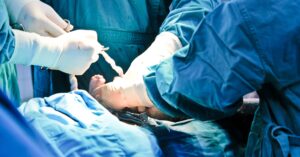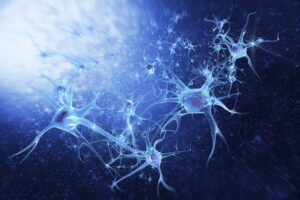
“Scars have the strange power to remind us that our past is real.”
—Cormac McCarthy
Scars are a reminder of our past. But one scar, a C-section scar, serves as a reminder of our future. A C-section scar marks the beginning of your child’s life outside of the safe confines of the womb, visual proof that mothers would do anything for their children to thrive.
But for many women, C-section (short for cesarian section) scars become emotionally and physically troubling, triggering subsequent health problems and undue issues with confidence and self-image. When looking back on the birth of your child, you should feel strong, proud, and enthusiastic about what you accomplished, and for some women, this will require addressing lingering problems with C-section scars.
Today we’re exploring the potential complications associated with C-section scars, why they should be addressed, and how to do so in a natural, drug-free way with microcurrent therapy.
C-Sections on the Rise Globally

C-sections have saved countless lives, and without them, the risk of childbirth would be much greater than it currently is. But experts are observing a sharp rise in the incidence of C-section births worldwide, especially in wealthier nations.
Lets’ take North America, for instance. In 2000 it was reported that roughly 24% of births were by C-section. Jump to 2015, where that number rose to 32%.
In fact, C-sections are the most common surgery performed in the United States, with a whopping 1.3 million being performed each year. So, if you’re living with the lingering side effects of a C-section birth, know you’re not alone, and help is available.
With this sharp increase in cesarian sections worldwide, doctors, midwives, and doulas are witnessing more and more complications associated with C-section scars, creating the need for an innovative, effective, and natural approach to addressing this common problem.
7 Common Complications Associated with C-Section Scars

These are some of the most common complications to be aware of if you’ve had a C-section birth:
- Placenta Accrete— This condition happens when the placenta implants itself near a pre-existing C-section scar. Placenta accrete has the ability to cause complications in subsequential births.
- Scar Sensitivity— Many new moms find it painful to bend over, pick up their baby, or reach over their head due to sensitive scar tissue.
- Changes in Posture— When abdominal muscles become weak or damaged due to a C-section, many mothers will feel their posture shifting. Without the support of abdominal muscles, the body begins to pull forward, causing many back problems.
- Ligament Injuries— Your body has a round ligament that connects the sides of your uterus to the labia, and it can be caught up in scar tissue after you have a C-section. This situation can result in lingering labial pain.
- Digestion Issues—C-sections can cause digestion issues like IBS or constipation due to tightening of the abdominal cavity caused by scar tissue.
- Trigger Points—Some women report trigger points that cause pain to areas like the urethra or clitoris due to scar tissue.
- Adhesions— In over 80% of C-sections, women will develop abdominal adhesions. Adhesion is defined as scar tissue that binds tissue or organs together. Adhesions lead to various problems including irregular bowel movements, chronic abdominal pain, digestive disorders, endometriosis, blocked circulation, intestinal obstruction, stagnant energy flows, activation of the fear reflex, and negative influence on the sympathetic nervous system.
How C-section Scars Disrupt Electrical Communication in Your Body
Your entire body is electrical, and your skin is no exception. Scarring breaks down the epidermis of your skin—changing its electrical properties.
The bottom line is this: scar tissue obstructs the electrical communication of your body. And if a scar is left untreated, you face not only pain and infection but also flawed communication from the injured area to your brain. The result? A delayed or incomplete healing process.
If you experience poor electrical communication in your body due to a C-section scar, your entire nervous system can be thrown out of whack—hindering your healing capabilities for years to come.
How to Move on From C-Section Scars—A Solution Backed by Science
So, is it possible for women who’ve experienced a C-section to restore electrical communication, heal scar tissue, address post-surgical pain, and more?
One study conducted by the Center for Pain & Stress Research in Toronto, Canada, suggests that the answer is a resounding “yes,” and microcurrent therapy may be the answer.
Here’s how the research was conducted:
The study examined treatment outcomes before, directly after, and two days after microcurrent therapy when applied to C-section scars in 47 women who experienced a post-surgical pain syndrome.
Microcurrent therapy was applied bi-laterally along the length of C-section scars for each patient. A pain assessment was conducted after microcurrent therapy and then again 48 hours later with all 47 participants.
The result: All 47 patients with chronic pain reported a statistically significant reduction in pain levels (67.5% of participants). This research provides hope to the millions of women worldwide who are ready to move past their C-section scars’ residual symptoms.
Additionally, a case report published in the Journal of Wound Care further suggests that various scars and wounds could be helped with microcurrent therapy. The case report was conducted in collaboration with 100 patients with chronic wounds such as diabetic foot ulcers, pressure ulcers, and venous leg ulcers.
Throughout a four-week treatment period:
- 100% of participants had a reduction in wound size.
- Sixteen patients (16%) reported having complete wound closure.
- 89% of patients who had reported pain associated with their wound experienced a reduction in pain.
- And eleven patients (11%) reported that they were completely pain-free at the end of the four weeks.
These are just two examples that demonstrate the possibilities of addressing C-section scars with microcurrent therapy.
Microcurrent Therapy: An Innovative Solution to C-Section Scar Complications
If you’ve tried everything with no relief, or you want to avoid conventional approaches to addressing C-section scar tissue altogether, microcurrent therapy is a viable option with encouraging results that are backed by science.
Microcurrent therapy is a treatment that is non-invasive, pain-free, and appropriate for all ages. It works by delivering gentle yet powerful electrical pulses through your body and encourages your body to heal itself on a cellular level.
How Does Microcurrent Address C-Section Scars?

The channels that facilitate the flow of energy in and out of your cells are blocked when scar tissue is present because scar tissue is more positively charged than healthy skin.
Microcurrent C-section scar treatments work by stimulating your cells to produce ATP. You may have heard of ATP; it’s an organic chemical that provides your body with the energy for nearly all biological processes.
Microcurrent therapy repolarizes scar tissue, restoring cell membrane function, releasing adhesions, and relaxing muscle tissue (all common complaints associated with C-section scars).
Heal Emotionally and Physically from C-section Scars
We all know scars can be troubling both emotionally and physically, and that’s just unfair. If you’re ready to get back to the life you once had, it may be time to level the playing field by addressing the complications of your C-section scar with microcurrent therapy.
As scientists and researchers further explore the possibilities that microcurrent healing presents for C-section scars, a renewed hope is blossoming for the millions of women worldwide who silently suffer from this all too common problem.
If you want to learn more about whether or not this is the right therapy for you, schedule a no obligation complimentary consultation with one of our trained specialists today.





